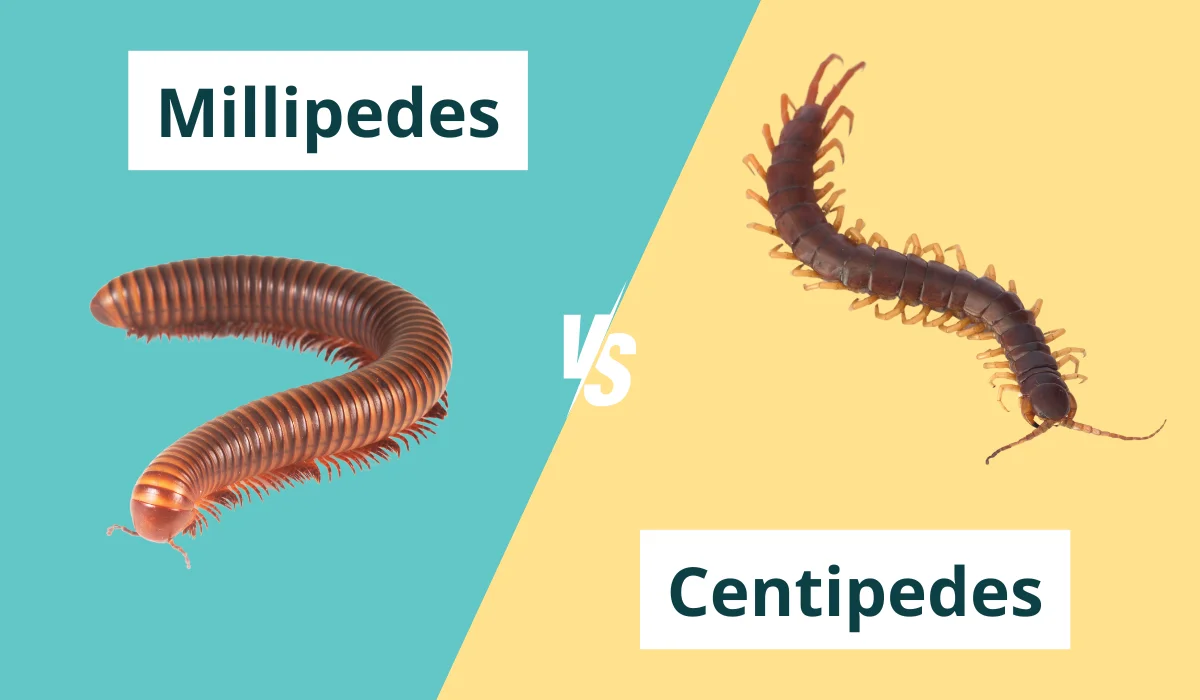Millipedes vs. Centipedes: What’s the Difference?
Stumbling upon a creature with long, segmented bodies scuttling across the path at night can be unsettling. Is it a millipede, or is it a centipede?
Millipedes and centipedes might look similar, but they have very distinct differences that are crucial to know. Keep reading to find out what sets these creepy crawlies apart.
Key Takeaways
- Millipedes have round bodies with two pairs of legs on each segment, while centipedes have flat bodies with only one pair per segment.
- Millipedes protect themselves by curling up and releasing chemicals, but centipedes move quickly and use venom to defend themselves.
- Millipedes are relatively safe for humans, but centipedes can bite and cause pain and swelling.
- To get rid of millipedes and centipedes, seal entry points, control moisture, and call pest control for appropriate treatment.
Millipedes vs. Centipedes: Key Differences

Millipedes and centipedes might look similar at first glance. But, they have distinct characteristics that set them apart. To distinguish between the two, consider the following.
Features | Millipedes | Centipedes |
Body Shape | Cylindrical bodies | Flattened bodies |
Antennae | Short antennae | Long antennae |
Coloring | Generally dark brown | Often reddish or brown |
Detritivores, decaying plant matter | Carnivores, small insects | |
Defense Method | Coiling and chemical secretion | Speed and venomous bite like a bee sting |
Preferred Environment | Leaf litter, damp areas | Damp areas with prey |
Common Locations | Basements, mulch | Crawl spaces, under rocks |
Are These Creepy-Crawlies Dangerous?
Species of millipedes and centipedes may be unwelcome guests in many homes, but are they really dangerous? To help you decide how best to handle them, you must understand their potential risks.
Millipedes are generally harmless to humans since they feed on organic matter. When threatened, they release a foul-smelling liquid.
Direct contact with this liquid can cause mild skin irritation, so it is wise to avoid handling them barehanded. Despite their intimidating appearance, they are not aggressive.
Meanwhile, centipedes can pose more of a concern. Like scorpions, these carnivorous invertebrates use venom to subdue their prey. While centipede bites on humans are generally not life-threatening, they can be quite painful. Larger species may cause more intense reactions.
How to Get Rid of These Creepy-Crawly Pests
Getting rid of millipedes and centipedes can be straightforward with the right approach. To keep these critters out of your home, here's a quick checklist to guide homeowners like you:
- Seal entry points using caulk or weatherstripping. Since gaps and cracks might become entryways, doing this will help block these access paths effectively.
- Install a dehumidifier in damp areas to control moisture levels. Since they thrive in humid conditions, this will discourage them.
- Remove other pests, such as ants, cockroaches, or spiders, to limit the food supply of house centipedes. Professionals or DIY pest control can help remove these food sources.
- Keep the garden trimmed and free of excessive mulch near the home's foundation. This reduces millipede populations outside, especially when starting their new life cycle.
If the pests are present in large numbers, professional pest control might be necessary. They can apply appropriate treatments to reduce the population while ensuring the safety of your household.
Should You Consider Pest Control?
When it comes to millipedes and centipedes, many people might wonder if professional pest control is necessary. If you’re dealing with a significant infestation of millipedes or centipedes, professional pest control companies (like us at Native Pest Management) may be necessary.
As experts, we can suggest treatments when infestations are unmanageable or persistent. If you’re uncomfortable handling products, you can hire us to keep these multi-legged neighbors at bay.
